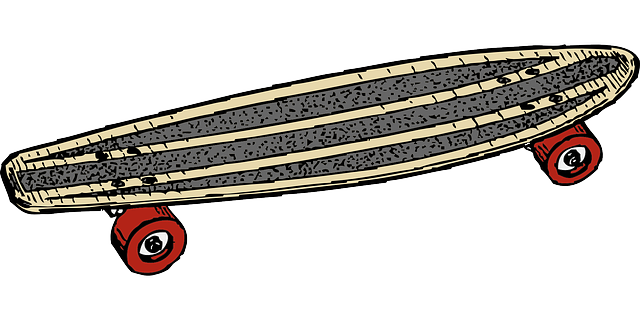Choosing the right deck length for a longboard is vital for a beginner-friendly experience. A medium-length board (110-120cm) offers stability and maneuverability, ideal for learning. Longer boards are great for cruising and commuting, while shorter ones are better for tricks and tight spots. Beginners should start with a longer deck for balance, then progress to shorter decks as skills improve. Deck length influences riding style, speed, and trick performance, making it key for newcomers to select a versatile length that caters to their evolving preferences.
“Uncover the secrets of extended deck lengths in longboarding, a popular choice among beginners seeking enhanced stability and control. This comprehensive guide explores why longer boards are ideal for newcomers. From understanding fundamental concepts like deck length’s impact on balance to advanced tips for mastering turns, this article caters to every learning stage. Discover various longboard types, crucial factors to consider when choosing a deck, and real-life insights from the vibrant community. Elevate your longboarding journey today.”
Understanding Deck Length: A Beginner's Guide

Deck length is a fundamental aspect to consider when choosing your first longboard, especially as a beginner. It directly impacts your board’s performance and your overall riding experience. In simple terms, deck length refers to the distance between the nose (front) and tail (back) of the board. Typically, longboards range from 90cm to over 150cm in length. For newcomers to the world of longboarding, a good starting point is a medium-length board, usually around 110-120cm. This length offers an excellent balance between stability and maneuverability, making it easier to learn basic techniques like carving, pushing, and turning.
A longboard’s deck length influences its speed, agility, and the type of riding you’ll engage in. Longer boards tend to be faster and more stable at high speeds, ideal for cruising and commuting. Conversely, shorter decks offer better maneuverability, making them perfect for tricks, dancing, and navigating tight spaces. As you progress from beginner to intermediate levels, you can experiment with different deck lengths based on your preferences and the type of longboard riding you wish to explore.
Longboard Basics: Why Choose a Longer Board?

For beginners looking to explore the world of longboarding, choosing a longer deck is often a strategic decision that offers numerous advantages. A longer board provides increased stability, making it easier for new riders to maintain balance and control during their learning journey. This is especially beneficial as it allows for more time to develop confidence before tackling more technical maneuvers.
The extended length also facilitates a smoother and more controlled glide, enabling beginners to cover larger distances with each push. This feature is ideal for cruising around campus or down smooth city streets, making longboards an excellent choice for commuter students or urban dwellers who want a fun and eco-friendly way to get around.
Deck Length and Stability: What Newbies Need to Know

For a longboard for beginners, deck length plays a crucial role in determining stability and control. Generally, longer decks provide more stability, making them ideal for newcomers who are still learning to balance and carve turns. However, this comes with a trade-off – longer boards tend to be less agile and may require more effort to initiate turns and change direction.
Beginners should consider their skill level and riding style when choosing a deck length. A common recommendation is to start with a board around 90-100cm for beginners, as it strikes a balance between stability and manoeuvrability. As skills improve, riders can transition to shorter decks, typically below 85cm, for enhanced agility and easier carving.
Types of Longboards: Options for Every Learning Style

When it comes to choosing a longboard, there’s an option to suit every learning style and skill level. For newcomers to the world of longboarding, a longboard for beginners should be chosen with care. Smaller deck sizes between 28-31 inches are often recommended as they provide better maneuverability and control, making it easier for first-timers to learn how to push, turn, and stop. Deck shapes can vary from drop-through designs that offer a lower center of gravity, aiding in stability, to pintail shapes, which are versatile and great for cruising.
Beyond the basics, longboards cater to more advanced riders too. Fish boards with their unique fin-like tail and larger deck sizes excel at carving and surfing on land. Cruiser boards, often longer and wider, are built for comfort and speed, ideal for commuting or leisurely rides. For those who love downhill racing, drop-down (dropper) longboards provide extreme stability at high speeds, while dance boards with their small, flexible decks allow for intricate footwork and tricks in skateparks.
Selecting the Right Deck: Factors Affecting Length

When it comes to choosing a longboard, one of the key decisions is determining the ideal deck length, especially for first-time riders often looking for a longboard for beginners. The deck length significantly impacts the board’s performance and handling. Factors such as height, weight, riding style, and terrain play a crucial role in this selection.
For instance, shorter decks are more agile and suitable for tricks and urban commuting, while longer decks offer better stability and speed for cruising and downhill riding. Beginners might prefer slightly longer decks to provide balance and control. Consider your intended use; if you’re new to longboarding, opt for a versatile length that allows you to explore different riding styles, gradually adapting as your skills develop.
Advanced Tips: Mastering Turns with Extended Decks

When dealing with extended deck lengths on a longboard, understanding how to master turns becomes an art. For beginners, it’s crucial to start with a basic understanding of weight distribution and balancing. Lean into your turns, keeping your body close to the board, and focus on maintaining control while gradually increasing speed.
Practice makes perfect; find a quiet, open space to experiment. Begin with gentle curves, then challenge yourself with tighter turns. Remember, a longboard for beginners isn’t just about cruising; it’s about building confidence and skill, so take your time, stay patient, and enjoy the journey of mastering this unique riding style.
Safety First: How Deck Length Impacts Riding Techniques

When it comes to longboarding, choosing the right deck length is essential, especially for beginners looking to master various riding techniques. Safety should always be the top priority, as deck length directly influences stability and control while cruising, carving, or performing tricks. A longer deck provides more stability, making it ideal for newcomers as it allows them to focus on learning without worrying about losing balance. This extra length offers a larger platform, enabling riders to maintain better control at higher speeds and when executing sharp turns.
Conversely, shorter decks require more skill and experience. They offer agility and maneuverability, perfect for technical maneuvers and street longboarding. However, beginners should start with a longer deck to build a solid foundation in basic riding skills before advancing to more intricate techniques. By selecting the appropriate deck length, longboarders can enhance their learning curve, ensuring they develop proper safety habits from the beginning.
Community Insights: Real-Life Experiences with Longboards

For many, the appeal of a longboard lies not just in its sleek design but also in the diverse experiences it offers, especially for newcomers to the board scene. Longboards provide an accessible entry point for beginners who want to explore the art of cruising and carving. The longer deck allows for greater stability, making it easier for first-timers to learn the basics like pushing, turning, and maintaining balance.
Community insights reveal that longboards cater to various styles and preferences. From casual cruisers to downhill enthusiasts, there’s a board length to suit every need. For beginners, a standard 9′ to 10′ longboard is often recommended due to its balanced dimensions, offering both stability for learning and maneuverability for exploring different skating styles within the community.
